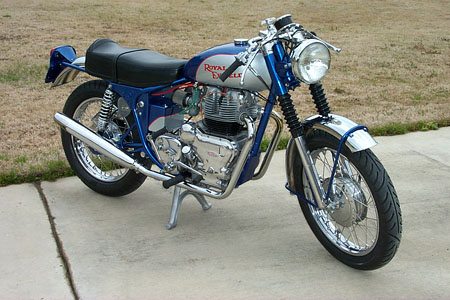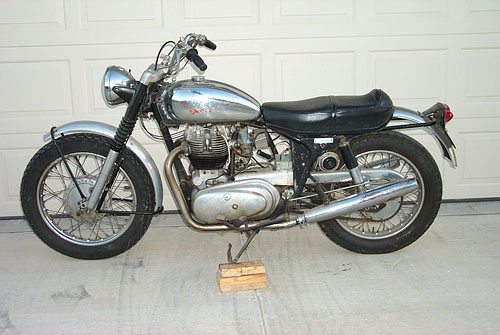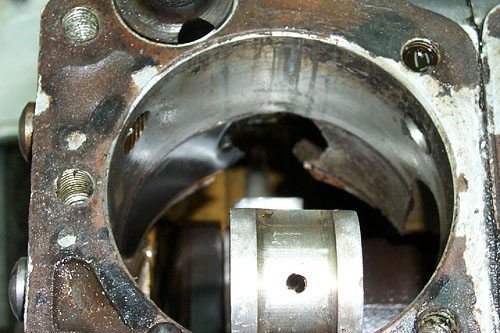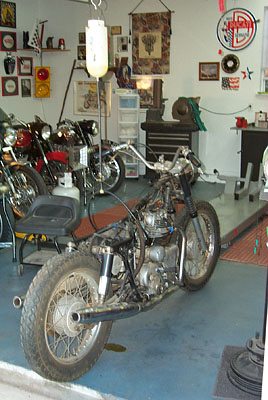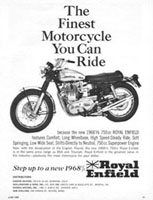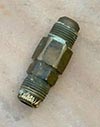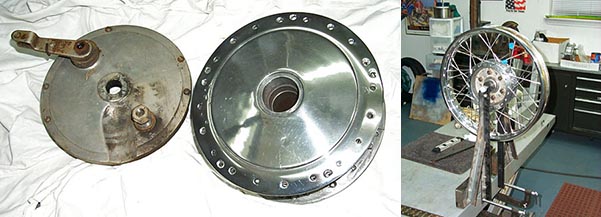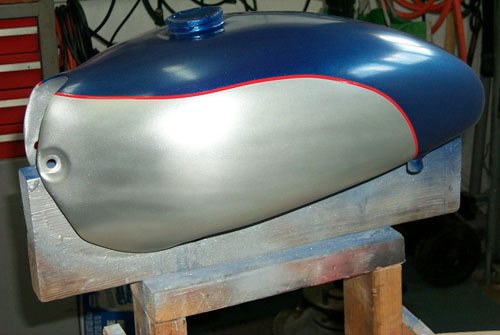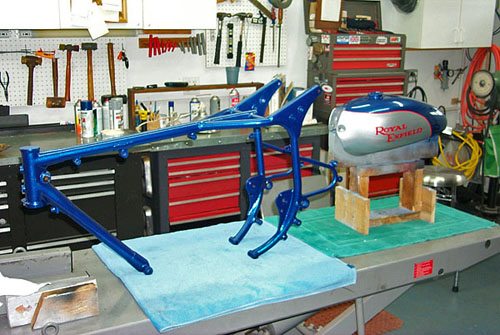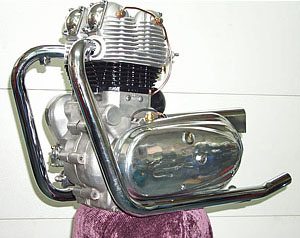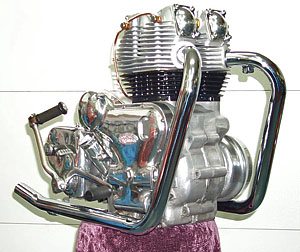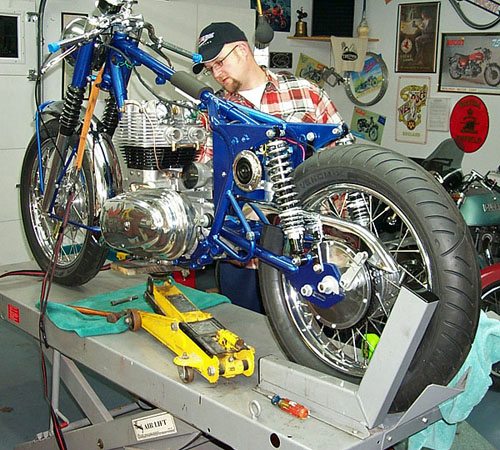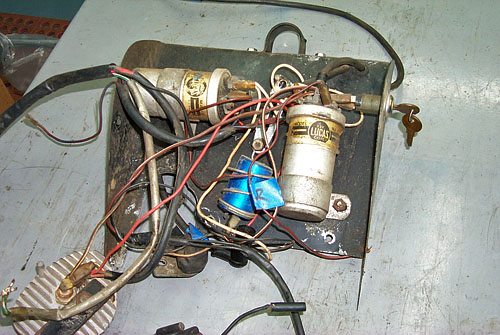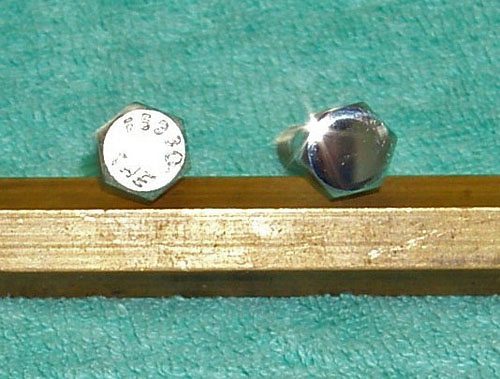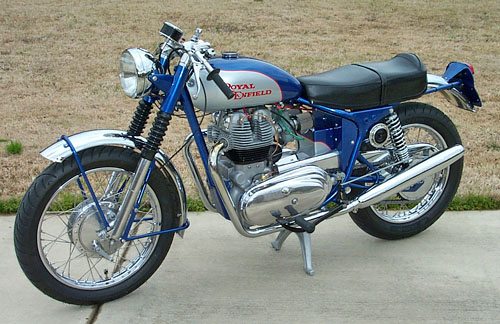1968 ½ Royal Enfield Interceptor “Custovation”
How We Met
Sometimes bikes find owners when they meet on the showroom floor. Sometimes they meet in a dimly lit garage with an odor of oil and gasoline in the air. This Rockers life story has none of that. It’s about patience and determination that lead to its ultimate survival.
A while back, I passed my 1960 Royal Enfield Road Interceptor to my oldest son, but that “Made Like a Gun” motorcycle still holds a special place on my list of most desired manly bikes.
During the summer of 1999, I got a second chance to own a Royal Enfield twin, but this time it would be the biggest of the twins and acquired under unusual circumstances.
As it turns out, a chap named Jim acquired the 1968 Interceptor 750 cc in 1971 while running a motorcycle shop in Dallas, Texas. Jim got a call from a lady who wanted to dispose of a bike that her son rode before leaving town for Arizona. He wouldn’t need it anymore since he met his ultimate fate someplace in the desert. Jim acquired the bike for free. All he had to do was pick it up.
Since Jim’s only mode of transportation those days was a motorcycle, he enlisted the help of a friend with a trailer. When he got there he clearly understood what the woman meant by “pick it up”. Jim had to pick up a lot.
In fact, the bike was an explosion of parts all over the backyard of her duplex. So he gathered up all the bike pieces he could find, and loaded them into the trailer. Initial inspection revealed a failed attempt at repairing severe damage caused when the Big Twin threw a rod.
Undaunted by the task ahead, Jim spent the next couple of years acquiring a new set of cylinders, pistons and rings and other needed parts. Contacting dealers and scouring motorcycle junkyards, his resourcefulness paid off and eventually he got the bike running.
Next came the hard part of restoring the Big Twin. After suffering through the resurrection of a damaged and disassembled bike, Jim’s great expectation of a full restoration skid to a halt, as interest in the project’s second phase dwindled rapidly.
The years passed on like a slow ride out of town. Still holding strong affection for the bike but knowing it was time to move on; Jim decided to find the bike a good home with someone who would restore it to its former glory.
Fate intervened about this time and through pure dumb luck, he and I met. He made me the same offer that his benefactor made him 28 years before: Pick it up and it’s yours for free, with one condition — treat it right. That’s was a heck of a deal for the Big Twin and me.
After almost four years of waiting in my shop, I started work to hold up my end of the bargain. Previously scheduled projects are completed and in January 2004, the Big Twin custovation work started.
Custovation is a blend of customizing and renovation to build a one-of-a-kind motorcycle. In this case, it’s about capturing the late ‘60’s café’ racer and Rocker heritage by blending the British big bore, long stroke vertical twin with some personal touches to turn heads.
My attraction to the Interceptor is its macho image — alloy and chrome are the Interceptor’s middle name and good looks are its game.
A handsome tough guy held together with an understated frame and plenty of bright-work.
The bike I acquired is the 1968 ½ transition model called the 750 twin Series I; The main difference between the Series I and II are oil cooler, better lubrication design and more efficient brakes.
An interesting feature that all Royal Enfield’s share is the separate lever on the gearbox; a clever device used to find neutral, regardless of the current gear selected. I found it more of a conversation piece than useful.
Will It Run?
Unless the engine of a project bike is seized or otherwise incapable of running, I always like to test the engine condition by attempting to get it to run. I figure if it ran recently, I can take it apart and get it running again.
First the compression was checked — good news, the right cylinder reads 130 psi and the left 100!
Not great on the left but certainly enough compression to squeeze the air and gas mixture into explosive submission. The carbs and points were cleaned, fresh oil and plugs were added and a new battery was lashed up to push the electrons around.
Much to my surprise, the horn, headlight, taillight and ammeter worked, sparks were strong and even though the electrical system was a tangle of original and add-on wires, there was no smoke or smell of melting insulation.
Finally, the moment of truth — bring it life with a little gas and a big boot for kicking. Because of previous engine experience, I had to make sure the oil pump is doing its job so the rocker covers were removed to confirm circulation.
Three stout kicks later and the Big Twin grumbles to life blowing out bits of rust and loose carbon that a moment before were living happily inside the silencers. The ammeter shows a good charge and the basic throttle response is good, no hesitation or backfiring, no unusual noises, just the sound of 750 cc alloy giant waking up.
After 25 years of silence, the Interceptor tells everyone who’s listening, that the BRITISH BAD BOY ROCKER is back in town.
After a detailed oil flow inspection, the left intake rocker was a bit dry compared to the other three rockers. Blowing some air in the oil feed line doesn’t fix the problem, so this will be fixed when the top end is removed.
Decisions, Decisions
Custovating this bike was supposed to be easier on my pocket book than some of my previous projects, so the functional components of the bike wouuld be left stock. I envisioned the Interceptor to be a good looking, good sounding, nostalgic café style rider but neither a garage queen nor high-speed runner. The fundamental engine, frame and brake design platforms have roots in the post War era, so it’s not practical to expect the package to perform near modern standards.
A Royal Enfield sets the bar on how polished alloy and chrome should blend with paint to make a clean and simple, good looking bike. The frame is understated and not much of an appearance element; it is spindly but with the right color, could be a strong visual compliment to the bright work.
That conclusion meant that a black-painted frame wouldn’t add any attention to the package. Several color schemes were tried on a Photoshop version, but the search ended when the fine-grained metallic cobalt blue color was found. Lay down some clear-coat for the ultimate gloss and what you have is a tasteful but spiffy visual combination.
Parts is Parts
Like writing to Santa, the missing and needed replacement parts list was made and checked at least twice. The
bikes from the late 60’s are remarkably simple, so there just wasn’t much to the entire parts list.
The big ticket items are stainless spokes, chrome fenders, complete exhaust system, complete headlight assembly, center stand assembly, shocks and tires. To get that café look, ACE bars were chosen to smooth out the side profile and to lean the rider forward. The chain, front wheel bearings, cables and fork seals were worn and needed replacement.
Getting to Work
The project was separated into two main assemblies, the complete engine and the frame assembly.
The frame, suspension and electrical was tackled first to establish a finished rolling frame waiting for the engine. I found this to be the best way to keep motivated during the time period when a custovation is in process.
The frame and its attachments were pressured washed to remove most of the caked on goo. While moving the frame around, a loud metallic clunk materialized when the frame was tilted to and fro along the line of the backbone.
Much to my surprise, a prankster in the Redditch frame assembly area installed a gift in the form a large brass natural gas line coupler (photo left).
The huge lump of brass was just the right size to slide around inside the end of the backbone tube under the seat.
This was no accident — the only way the coupler could have found its way into the backbone is just before the final cross tubes were welded.
Pity the bloke that rode this bike home and had to listen to that mysterious intermittent banging as the coupler methodically slid back and forth hitting the frame tubes in a ghostly manner.
I exorcised the coupler by cutting open the tube section and re-welding. The coupler is now mounted as a trophy dedicated to the anonymous frame builder at the Redditch works.
The Dirtiest Jobs
Buffing is by far the dirtiest job in the shop, but it pays off big in appearance. I use a three-step approach with decreasing degrees of abrasion and spiral wound cotton buffs.
All the steel frame parts were blasted with aluminum oxide and immediately primed.
The frame was too big to fit in the metal blaster box, so I got a large-screen TV carton from a retailer and used it as a temporary blasting box. The media was siphoned from a bucket using the blaster box gun and regulator. It worked perfect!
There was a fair amount of dust so I wore a NIOSH-approved respirator and goggles. The box captured the media so it could be vacuumed up and dumped in the bucket for more blasting. Before priming, the original weld splatter nibs and casting seams were removed for a more finished look.
The hubs were cleaned and polished. The brake shoes are in good shape so they only needed cleaning. The front wheel bearings were replaced with sealed units.
The wheels laced with stainless steel spokes and nipples using my homemade truing stand. I like building and lacing wheels since this is something I learned a long time ago from my Dad. Finishing off this part of the project called for mounting fresh Avon Venom X’s, ready for the road.
Fuel Tank
In my mind’s eye I saw the Interceptor with its signature chrome gas tank gleaming from every angle. With the years of crud on the chrome the tank appeared to be in pretty good shape, but then I cleaned and polished it to reveal what was hiding underneath — several small but pointed dents and lots of scratches and a few places where the chrome failed to keep back the rust.
So the tank and I went looking for a chroming shop willing to tackle the repair / re-chrome project. I came up blank, with only one motorcycle chrome specially shop estimating at least a grand for the task but then declining to get involved. Frankly, I wasn’t surprised.
Over the years the tank has seen its share of wear and abuse leaving noticeable character marks all over the shinny surface, so the solution was clear: paint the entire tank. I’ve seen some BSA tanks that were intended to have chrome sides painted over with tasteful silver paint in the chrome places, so that’s what I did.
To make the paint stick better, I chose to bead blast the entire tank to remove the chrome glaze. In the process of applying the body filler I decided to remove the ugly front mounting flange by blending the sides of the tank forward. The results made the tank look longer and more noticeable.
All the painting took place in the garage inside a plastic sheet spray booth.
Engine
The bottom end appeared to be sound; besides the rod damage from the old days, the fully assembled bottom end was cleaned with repeated kerosene flushing to remove as much of the sediment as possible. New rings, gaskets, clutch plates and primary chain tensioner were all that was needed to complete this stage.
Head Ache
The top end presented a special problem. When the engine was damaged long ago, Jim replaced one of the cylinders from an earlier 750, but Royal Enfield twins use two separate cylinders rather than one cast unit. The replaced cylinder had some leakage problems that were cured by a fresh head gasket and some sealant. The alternator stator also needed rewiring to refresh the connections to the charging system.
Bling
One of the most rewarding events of the project was seeing the fully assembled polished engine, waiting to be reunited to the frame. Royal Enfield designers had an eye for the bling! The 750 twin engine is one of the most stunning examples of mechanical jewelry ever.
Assembly
With help from Bill and jack, the engine slid right into the frame. A few bolts, Ace bars and the transformation into a ride-able bike began.
The wiring came next; the needed connections are simple since there’s not much to connect. The Royal Enfield has a remarkably simple electrical system; a distributor, two, coils, battery, shunt Zener regulator and a couple of switches to control the lights and ignition.
The entire wiring loom was rebuilt to ensure there would be no future electrical connection problems. I like to use multi-strand marine grade wiring because it holds up well under vibration and resists breaking.
The points were replaced with a Boyer electronic ignition, the same type used for vintage Triumphs. They are easy to install and once adjusted, never need attention. That’s a big change from the stock dual-points setup that per factory suggestion needed cleaning and adjustment about very 1500 miles!
All standard hardware was replaced with stainless. For bolts that are in prominent view, I smooth the bolt tops on a sander and then polish. For the effort, they look like chrome and are a lot cheaper. This adds an eye-catching detail to the any project and raises the quality of the build.
The original bike had an alloy front fender and chrome rear — neither looked very good. The new rear shocks were slightly longer and hiked up the fender too much for my liking, so both fenders were replaced.
However, to get the proper rear tire to fender spacing, I lowered the rear-most mounting with shims. This made a big difference in appearance difference. The final assembly came together with-out a hitch.
Riding
With the fluids topped off, gas and a little tickle to the Amals, the Bad Boy Rocker roared to life on the second hefty kick. What a sound!
This is a man’s bike with a throaty sound and engine girth sporting bulbous cylinder fining. Its long stroke engine is designed for torque and it gives the rider a sensation that there’s a giant magnet pulling him forward. Open the throttle in top gear and you unleash a load of power that makes your hair prickle up. At idle, it’s subdued and ticks over with big thumps coming out of the silencers.
The Bad Boy Rocker became an instant head-turner at stoplights. The silver / chrome / blue colors and textures make sure it gets a second look. People not familiar with vintage English bikes mistake it for anything but British.
In fact Royal Enfield strikes no reference point for them. That’s fine with me. I t gives me another opportunity to talk about the bike, the makers and how we first met.
More on webBikeWorld
- Isle of Man TT Report – Vin Heron
- Cromwell Spitfire Helmet Review
- Nexx X60 Helmet Review
- 1968 Royal Enfield Restoration
- Mods and Rockers Book Review
- Ace Café Reunion and Brighton Burn-up (report).
Royal Enfield Resources
- Royal Enfield Motorcycles
- Hitchcock’s Motorcycles – experts and parts for all Royal Enfields.
- Motorcycle Specialties – long time Royal Enfield dealer now providing parts. Sam Avelllino 781-284-5157
- Royal Enfield Owners Club (UK)
- Royal Enfield Interceptor Owners Association (UK)
Learning
Owner Comments and Feedback
See details on submitting comments.
From “A.S.” (February 2013): “What a beautiful machine! The Interceptor reminded me of my 1961 Constellation that I purchased as a ‘basket case’ in late 1970. When I made the purchase, I was still at high school! I rebuilt the machine so as I had some transport whilst undergoing my engineering training during the early 1970s.
I think that I’m going to have to find another basket case to rebuild. Just hope that it’s another Royal Enfield twin. Many thanks for publishing the article: It’s brought back many happy memories of times past.”
From “I.G.” (September 2011): “Great job. It’s a pleasure to see someone with taste. Only 2 things I wish it had: 1. The tank looks MUCH better with the front “faired in”- but some chrome just wants to be there.
2. The fake “coolers” are missing from the front brake to make it appear to be 8″ (and a sort of “disk”) instead of the stock 7″ drum while just cosmetic were also an integral part of the “Enfield look”!”
From “S” (02/11): “Well Done! Bike looks fantastic, personally, I think it’s “better” than original! Always loved “oilfields” as we called them here in the UK, I had a few 250s and 350s and always hankered after a big twin!
Sadly, being young and impoverished meant I never fulfilled my dream back in the early 70s. Looking at this makes me want to start trawling the for sale ads! Very underrated Enfield, in some ways better than Triumphs or Beezas but never seemed to catch Joe Public’s imagination as much. Maybe cos of a lack of racing publicity? All the best :)”
From “D” (10/08): “See the Royal Enfield Interceptor Register (with) information pages and a record of Interceptors still around.”
From “J.B.”: “Congratulations and thanks to Joe in Dallas for the first class report on the rebuild of the ’68 Royal Enfield Interceptor. It’s an inspiration to the rest of us.”
From “W.R.C.”: “I loved the article on the Royal Enfield, because, when I first started to ride in high school (1968-1971), my best buddy, with whom I started riding, had an older brother, with this exact model of 1968 1/2 Royal Enfield!
Their parents were from the UK, and in the summer of love, 1969, they went to England, and brought back several bikes. One was a leading-axle Greeves dirt bike, that my friend Dave and I learned to ride on, the other 2 were the Royal Enfield, and a basket case Vincent Black Shadow (later restored to mint by Mike). Dave’s older brother Mike had the Enfield and Vincent.
He took the nearly new Enfield apart, and painted the frame bright yellow, and installed a set of flat bars on short risers. Dave and I were in grade 10, and Mike was a senior. Every day that fall, he rode the Enfield to school (even though it was just 2 blocks away!), and his bike was the machine in the school parking lot. I idolized that bike, the great sound it made, and the cool mild custom look Mike did to it. He was a devoted biker, and rode it every day until the snow fell that winter.
I always loved the look of that chrome gas tank, and for the rest of my life, I have wanted an Enfield too. Now I ride an ’06 Ducati S2R 1000, and this summer, I have acquired a Monster Chromo tank for it. I intend to do a mild custom job on it this winter, and my inspiration for it will be my fond memories of that amazing Royal Enfield…”


